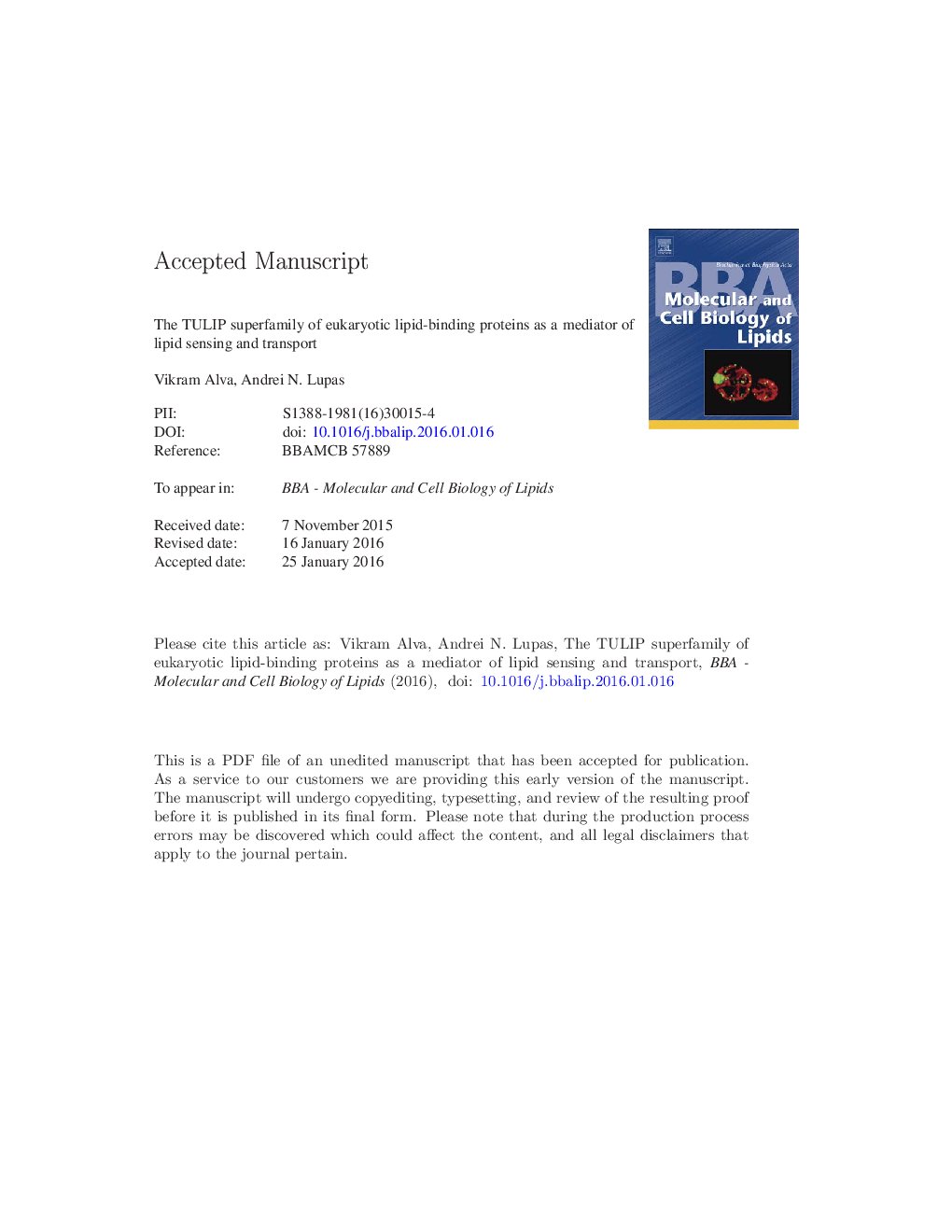| کد مقاله | کد نشریه | سال انتشار | مقاله انگلیسی | نسخه تمام متن |
|---|---|---|---|---|
| 8301664 | 1537702 | 2016 | 35 صفحه PDF | دانلود رایگان |
عنوان انگلیسی مقاله ISI
The TULIP superfamily of eukaryotic lipid-binding proteins as a mediator of lipid sensing and transport
دانلود مقاله + سفارش ترجمه
دانلود مقاله ISI انگلیسی
رایگان برای ایرانیان
کلمات کلیدی
موضوعات مرتبط
علوم زیستی و بیوفناوری
بیوشیمی، ژنتیک و زیست شناسی مولکولی
زیست شیمی
پیش نمایش صفحه اول مقاله

چکیده انگلیسی
The tubular lipid-binding (TULIP) superfamily has emerged in recent years as a major mediator of lipid sensing and transport in eukaryotes. It currently encompasses three protein families, SMP-like, BPI-like, and Takeout-like, which share a common fold. This fold consists of a long helix wrapped in a highly curved anti-parallel β-sheet, enclosing a central, lipophilic cavity. The SMP-like proteins, which include subunits of the ERMES complex and the extended synaptotagmins (E-Syts), appear to be mainly located at membrane contacts sites (MCSs) between organelles, mediating inter-organelle lipid exchange. The BPI-like proteins, which include the bactericidal/permeability-increasing protein (BPI), the LPS (lipopolysaccharide)-binding protein (LBP), the cholesteryl ester transfer protein (CETP), and the phospholipid transfer protein (PLTP), are either involved in innate immunity against bacteria through their ability to sense lipopolysaccharides, as is the case for BPI and LBP, or in lipid exchange between lipoprotein particles, as is the case for CETP and PLTP. The Takeout-like proteins, which are comprised of insect juvenile hormone-binding proteins and arthropod allergens, transport, where known, lipid hormones to target tissues during insect development. In all cases, the activity of these proteins is underpinned by their ability to bind large, hydrophobic ligands in their central cavity and segregate them away from the aqueous environment. Furthermore, where they are involved in lipid exchange, recent structural studies have highlighted their ability to establish lipophilic, tubular channels, either between organelles in the case of SMP domains or between lipoprotein particles in the case of CETP. Here, we review the current knowledge on the structure, versatile functions, and evolution of the TULIP superfamily. We propose a deep evolutionary split in this superfamily, predating the Last Eukaryotic Common Ancestor, between the SMP-like proteins, which act on lipids endogenous to the cell, and the BPI-like proteins (including the Takeout-like proteins of arthropods), which act on exogenous lipids. This article is part of a Special Issue entitled: The cellular lipid landscape edited by Tim P. Levine and Anant K. Menon.
ناشر
Database: Elsevier - ScienceDirect (ساینس دایرکت)
Journal: Biochimica et Biophysica Acta (BBA) - Molecular and Cell Biology of Lipids - Volume 1861, Issue 8, Part B, August 2016, Pages 913-923
Journal: Biochimica et Biophysica Acta (BBA) - Molecular and Cell Biology of Lipids - Volume 1861, Issue 8, Part B, August 2016, Pages 913-923
نویسندگان
Vikram Alva, Andrei N. Lupas,